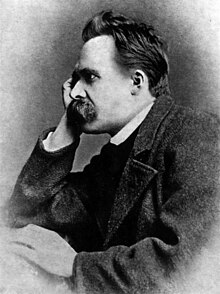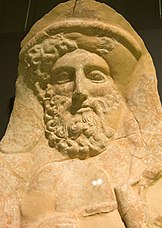Apollonian and Dionysian
The Apollonian and the Dionysian are philosophical and literary concepts represented by a duality between the figures of Apollo and Dionysus from Greek mythology. Its popularization is widely attributed to the work The Birth of Tragedy by Friedrich Nietzsche, though the terms had already been in use prior to this,[1] such as in the writings of poet Friedrich Hölderlin, historian Johann Joachim Winckelmann, and others. The word Dionysian occurs as early as 1608 in Edward Topsell's zoological treatise The History of Serpents.[2] The concept has since been widely invoked and discussed within Western philosophy and literature.
In Greek mythology, Apollo and Dionysus are both sons of Zeus. Apollo, son of Leto, is the god of the sun, art, music, poetry, plague and disease, of rational thinking and order, and appeals to logic, prudence and purity and stands for reason. Dionysus, son of Semele, is the god of wine, dance and pleasure, of irrationality and chaos, representing passion, emotions and instincts. The ancient Greeks did not consider the two gods to be opposites or rivals, although they were often entwined by nature.
Nietzschean usage
[edit]
Nietzsche found in classical Athenian tragedy an art form that transcended the pessimism found in the so-called wisdom of Silenus. The Greek spectators, by looking into the abyss of human suffering depicted by characters on stage, passionately and joyously affirmed life, finding it worth living. The main theme in The Birth of Tragedy is that the fusion of Dionysian and Apollonian Kunsttriebe ("artistic impulses") forms dramatic arts or tragedies. He argued that this fusion has not been achieved since the ancient Greek tragedians. Apollo represents harmony, progress, clarity, logic and the principle of individuation, whereas Dionysus represents disorder, intoxication, emotion, ecstasy and unity (hence the omission of the principle of individuation). Nietzsche used these two forces because, for him, the world of mind and order on one side, and passion and chaos on the other, formed principles that were fundamental to the Greek culture:[3][4] the Apollonian a dreaming state, full of illusions; and Dionysian a state of intoxication, representing the liberations of instinct and dissolution of boundaries. In this mould, a man appears as the satyr. He is the horror of the annihilation of the principle of individuality and at the same time someone who delights in its destruction.[5]
Apollonian and Dionysian juxtapositions appear in the interplay of tragedy: the tragic hero of the drama, the main protagonist, struggles to make (Apollonian) order of his unjust and chaotic (Dionysian) fate, though he dies unfulfilled. Elaborating on the conception of Hamlet as an intellectual who cannot make up his mind, and is a living antithesis to the man of action, Nietzsche argues that a Dionysian figure possesses the knowledge that his actions cannot change the eternal balance of things, and it disgusts him enough not to act at all. Hamlet falls under this category—he glimpsed the supernatural reality through the Ghost; he has gained true knowledge and knows that no action of his has the power to change this. For the audience of such drama, this tragedy allows them to sense what Nietzsche called the Primordial Unity, which revives Dionysian nature. He describes primordial unity as the increase of strength, the experience of fullness and plenitude bestowed by frenzy. Frenzy acts as intoxication and is crucial for the physiological condition that enables the creation of any art.[citation needed] Stimulated by this state, a person's artistic will is enhanced:
Nietzsche is adamant that the works of Aeschylus and Sophocles represent the apex of artistic creation, the true realisation of tragedy; it is with Euripides, that tragedy begins its Untergang (literally 'going under' or 'downward-way;' meaning decline, deterioration, downfall, death, etc.). Nietzsche objects to Euripides' use of Socratic rationalism and morality in his tragedies, claiming that the infusion of ethics and reason robs tragedy of its foundation, namely the fragile balance of the Dionysian and Apollonian. Socrates emphasised reason to such a degree that he diffused the value of myth and suffering to human knowledge. Plato continued along this path in his dialogues, and the modern world eventually inherited reason at the expense of artistic impulses found in the Apollonian and Dionysian dichotomy. He notes that without the Apollonian, the Dionysian lacks the form and structure to make a coherent piece of art, and without the Dionysian, the Apollonian lacks the necessary vitality and passion. Only the fertile interplay of these two forces brought together as an art represented the best of Greek tragedy.[6]In this state one enriches everything out of one's own fullness: whatever one sees, whatever wills is seen swelled, taut, strong, overloaded with strength. A man in this state transforms things until they mirror his power—until they are reflections of his perfection. This having to transform into perfection is—art.
Later usages
[edit]Continental philosophy
[edit]Nietzsche's idea has been interpreted as an expression of fragmented consciousness or existential instability by a variety of modern and post-modern writers, especially Martin Heidegger, Michel Foucault and Gilles Deleuze.[7][8] According to Peter Sloterdijk, the Dionysian and the Apollonian form a dialectic; they are contrasting, but Nietzsche does not mean one to be valued more than the other.[9] Truth being primordial pain, our existential being is determined by the Dionysian/Apollonian dialectic.
Extending the use of the Apollonian and Dionysian onto an argument on interaction between the mind and physical environment, Abraham Akkerman has pointed to masculine and feminine features of city form.[10]
Ruth Benedict
[edit]Anthropologist Ruth Benedict used the terms to characterize cultures that value restraint and modesty (Apollonian) and ostentatiousness and excess (Dionysian). An example of an Apollonian culture in Benedict's analysis was the Zuñi people as opposed to the Dionysian Kwakiutl people.[11] The theme was developed by Benedict in her main work Patterns of Culture.
Albert Szent-Györgyi
[edit]Albert Szent-Györgyi, who wrote that "a discovery must be, by definition, at variance with existing knowledge",[12] divided scientists into two categories: the Apollonians and the Dionysians. He called scientific dissenters, who explored "the fringes of knowledge", Dionysians. He wrote, "In science the Apollonian tends to develop established lines to perfection, while the Dionysian rather relies on intuition and is more likely to open new, unexpected alleys for research...The future of mankind depends on the progress of science, and the progress of science depends on the support it can find. Support mostly takes the form of grants, and the present methods of distributing grants unduly favor the Apollonian".[12]
Camille Paglia
[edit]American humanities scholar Camille Paglia writes about the Apollonian and Dionysian in her 1990 bestseller Sexual Personae.[13] The broad outline of her concept has roots in Nietzschean discourse, an admitted influence, although Paglia's ideas diverge significantly.
The Apollonian and Dionysian concepts comprise a dichotomy that serves as the basis of Paglia's theory of art and culture. For Paglia, the Apollonian is light and structured while the Dionysian is dark and chthonic (she prefers Chthonic to Dionysian throughout the book, arguing that the latter concept has become all but synonymous with hedonism and is inadequate for her purposes, declaring that "the Dionysian is no picnic"). The Chthonic is associated with females, wild/chaotic nature, and unconstrained sex/procreation. In contrast, the Apollonian is associated with males, clarity, celibacy and/or homosexuality, rationality/reason, and solidity, along with the goal of oriented progress: "Everything great in western civilization comes from struggle against our origins".[14]
She argues that there is a biological basis to the Apollonian/Dionysian dichotomy, writing: "The quarrel between Apollo and Dionysus is the quarrel between the higher cortex and the older limbic and reptilian brains".[15] Moreover, Paglia attributes all the progress of human civilization to masculinity revolting against the Chthonic forces of nature, and turning instead to the Apollonian trait of ordered creation. The Dionysian is a force of chaos and destruction, which is the overpowering and alluring chaotic state of wild nature. Rejection of—or combat with—Chthonianism by socially constructed Apollonian virtues accounts for the historical dominance of men (including asexual and homosexual men; and childless and/or lesbian-leaning women) in science, literature, arts, technology and politics. As an example, Paglia states: "The male orientation of classical Athens was inseparable from its genius. Athens became great not despite but because of its misogyny".[16]
See also
[edit]- "Cygnus X-1 Book II: Hemispheres", a song by Canadian rock band Rush based in part on the concept.
- The Decline of the West
- Faust
- Light and dark side of the Force
- Logocentrism
- Master-morality and slave-morality
References
[edit]- ^ Adrian Del Caro, " Dionysian Classicism, or Nietzsche's Appropriation of an Aesthetic Norm" (in English), in Journal of the History of Ideas, Vol. 50, No. 4 (October–December 1989), pp. 589–605. JSTOR 2709799.
- ^ Topsell, Edward (1608). The History of Serpents. Published by William Jaggard.
- ^ "Nietzsche, Dionysus and Apollo". www.historyguide.org.
- ^ Desmond, Kathleen K. (2011). Ideas About Art. John Wiley & Sons. ISBN 978-1-4443-9600-3 – via Google Books.
- ^ "Nietzsche's Apollonianism and Dionysiansism: Meaning and Interpretation". bachelorandmaster.com.
- ^ "SparkNotes: Friedrich Nietzsche (1844–1900): The Birth of Tragedy". sparknotes.com.
- ^ Michael, Drolet (2004). The Postmodernism Reader. Routledge. ISBN 9780415160841.
- ^ Postmodernism and the re-reading of modernity By Francis Barker, Peter Hulme, Margaret Iversen, Manchester University Press,1992, ISBN 978-0-7190-3745-0 p. 258
- ^ Thinker on Stage: Nietzsche's Materialism, translation by Jamie Owen Daniel; foreword by Jochen Schulte-Sasse, Minneapolis, University of Minnesota Press, 1989. ISBN 0-8166-1765-1
- ^ Akkerman, Abraham (2006). "Femininity and Masculinity in City-Form: Philosophical Urbanism as a History of Consciousness". Human Studies. 29 (2): 229–256. doi:10.1007/s10746-006-9019-4. S2CID 144871101.
- ^ Benedict, Ruth (January 1932). "Configurations of Culture in North America". American Anthropologist. 34 (1): 1–27. doi:10.1525/aa.1932.34.1.02a00020.
- ^ a b Szent-Györgyi, Albert (1972-06-02). "Dionysians and Apollonians". Science. 176 (4038): 966. doi:10.1126/science.176.4038.966.a. ISSN 0036-8075. PMID 17778411. S2CID 239854822.
- ^ Paglia, Camille (1990). Sexual Personae: Art and decadence from Nefertiti to Emily Dickinson. New York: Vintage Book. ISBN 9780300043969.
- ^ Paglia (1990), p. 40
- ^ Paglia (1990), p. 96
- ^ Paglia (1990), p. 100.



